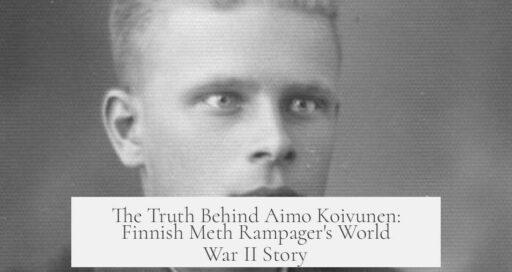The story of Aimo Koivunen, the Finnish soldier reportedly rampaging under the influence of methamphetamine during World War II, is rooted in some verified facts but blends reality with elements difficult to confirm. It mixes genuine wartime events with possible embellishments, hallucinations, and subjective narrations affecting its full legitimacy.
Aimo Koivunen is said to have overdosed on Pervitin, a methamphetamine-based stimulant used by soldiers, leading to an unusual survival story during the Continuation War on the Eastern Front near the Soviet border. The main elements—that he was separated from his unit, survived in harsh conditions, and endured physical and mental challenges—are largely supported by timeline facts and verifiable data.
The dates recorded place Koivunen’s separation on March 18, 1944, with his return on April 1, 1944. This suggests a two-week period during which he either wandered or concealed himself in subzero conditions (around -20 to -30 degrees Celsius) in northern Finnish Lapland, near Salla. The reported approximate distance he traveled was about 400 kilometers, which aligns with the time frame if interpreted as intermittent movement.
However, many aspects of the story reflect uncertainty and subjective interpretation. The “bender,” or overdose episode, reportedly lasted only a couple of days. This contradicts common retellings claiming he was under the drug’s influence for up to two weeks. It’s clear his comrades relieved him of weapons and ammunition early on because his behavior became erratic. This action indicates serious concern for his safety and that of others.
Hallucinations and strange behavior are key features of the story. Nonetheless, evidence suggests these symptoms resulted largely from exhaustion and stress rather than solely the stimulant itself. Fatigue can induce vivid hallucinations, particularly in extreme cold and isolation. While residual effects of methamphetamine may have contributed, exhaustion remains the primary cause of his mental state.
There is skepticism regarding his claim of spending a full week lying wounded in a hole. Some argue this period was likely shorter, and Koivunen may have spent more time moving on skis early in his separation. This distinction affects the narrative of endurance and suffering but does not negate his survival. Moreover, the detail about a Finnish patrol leaving him behind after losing their sergeant to a mine seems questionable due to typical military protocol, making that part less credible.
The source of the story is a magazine created by veterans and published by a reputable publisher. While the publication strives to provide veterans a platform in a time when Finnish war experiences were often neglected or politically sensitive due to the era’s leftist tendencies (“Finlandization”), this also means the narrative contains partiality. The article openly acknowledges the unreliable narration and the blend of truth and hallucination without claiming perfect accuracy.
Summarizing the critical facts:
- Koivunen did separate from his unit near March 18, 1944, and returned by April 1.
- He overdosed on Pervitin, leading to altered behavior and removal of his ammunition by comrades.
- His journey across harsh Arctic territory is plausible and somewhat verifiable.
- Hallucinations were mainly due to extreme exhaustion rather than the drug alone.
- Specific narrative elements, such as prolonged wounded concealment and patrol behavior, carry doubts.
- The story is published in a veteran-produced magazine, which carries partiality but retains credibility as a wartime account.
In essence, the story of Aimo Koivunen mixes documented wartime survival with layers of subjective experience and possible exaggeration. It remains a compelling tale illustrating the extreme conditions Finnish soldiers faced and the consequences of wartime methamphetamine use. The core events are supported by verified facts, yet some finer details should be treated with skepticism.
Key takeaways:
- Aimo Koivunen’s survival story has a factual basis coupled with unreliable narrative elements.
- The methamphetamine overdose episode lasted only a few days, not weeks.
- Hallucinations are chiefly linked to exhaustion and stress, not only drug effects.
- Some specific incidents, like extended wounded hiding and patrol behavior, seem questionable.
- The story comes from a veteran magazine, reflecting partiality but avoiding total fabrication.
- Overall, the story is a semi-credible wartime account blending fact and perception.




